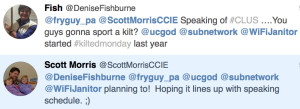Author Archives: Denise "Fish" Fishburne
Author Archives: Denise "Fish" Fishburne
“Hey Fish, how good are you at BFD? None of my BFD neighbors will come up.” Two simple sentences and I am “hooked.” I love troubleshooting! Troubleshooting is just a blast for me! It’s like being a Network Detective trying... Read More ›
The post Network Detective Series: Troubleshooting Method Ride-A-Long appeared first on Networking with FISH.
Ever since my blog, CiscoLive 2016: ‘Summer Camp for Geeks’, I’ve been getting questions about what my personal CLUS schedule typically looks like for the week. CiscoLive 2016 will be my 11th CiscoLive US (“#CLUS”) and my 13th CiscoLive in general.
It is my favorite work week of the ENTIRE year. And I look forward to it a great deal. At the same time…. it is not even one full week and one can miss so much they wished they hadn’t missed because the time flies by so quickly. And yes… I have learned this the hard way.
So… first things first – I came up with the list of things that are prioritizes to me for the week.
All that said…… Here ya go. My CiscoLive (CLUS) schedule for the week.
Put your detective hat on your head and your Network Detective badge on your lapel. It’s times for another installment in the Network Detective Series.
Are we going on our first “case” together? Nope. Not just yet. 
In this series I’m not going to be able to always call out every time my “techniques” and “methodologies” steer me one way or the other on a case. But over time you will notice there is a thread in there. A guiding framework and methodology.
So before we go on our first “case” together… I want to pass on to you what are really my major guiding principles for when I’m on a case. The “TOP” tips that I think have the biggest return on your time investment as a Network Detective.
Detection is, or ought to be, an exact science and should be treated in the same cold and unemotional manner.
-Sherlock Continue reading
Put your detective hat on your head and your Network Detective badge on your lapel. Introducing a new blog series – Techniques of a Network Detective. This series will focus on the detective work (troubleshooting side) of our jobs as network engineers.
For over 30 years I’ve been playing in the “world of IT”. During those years there have been a lot of changes in our world. But through all that change, there has been a thread, for me, that has always remained constant. A thread and a passion that always seemed to be with me in every job over all these years.
Troubleshooting!
Being a “Network Detective” is much the same as being a regular detective in many ways. As a Network Detective we get put on a “case” – the “Case of the Missing Packets” maybe. We go to the crime scene and try to find answers so we can solve the “who done it”
When a “crime” happens you need to be right there interviewing the suspects, surveying the crime scene, asking the right questions. Trying to quickly figure out what is happening, where it is happening, and why it Continue reading
The other day I was talking with a friend about my summer plans. As we were talking about July….. my face apparently lit up and my voice got all excited and happy when I mentioned CiscoLive.
“What exactly is CiscoLive?” she asked.
I answered, “CiscoLive is my absolute favorite work week of the entire year. Has been since my first one back in 2006.”
“What do you like so much about it?” she asked. ……
My answer to her? 
“It’s like a week long Summer Camp for Geeks”
Learning… learning… learning ….. learning. I just love learning! For me… learning from others and passing that on is one of my passions in life.
And WOW is there knowledge to learn at CiscoLive!
Of course, I have never been to a CiscoLive as a non Cisco employee. Nor have I ever gone and not been a speaker. So, for me, CiscoLive has always involved me prioritizing technical knowledge sharing/teaching with CiscoLive Continue reading
I use analogies. Just how my brain works…. and how I sometimes learn and teach. Token-ring source-route bridging analogy was “breadcrumbs thru the network”. Analogy for DLSw+ was a boat getting the breadcrumbs over water between 2 islands.
I think I like analogies cause…. to be superbly honest… when I came to work at Cisco back in 1996 I only knew SNA. I did NOT know IP. I was quickly immersed into learning IP. But I mean seriously… using acronyms to explain other acronyms you don’t understand? Don’t get me started!
Ready to play? Yea yea… my brain jumps around with varying analogies. If one doesn’t hit ya maybe the next will.  Happy nerding!
Happy nerding!
 Imagine you own a rental car agency with 2 locations across town from each other. Your employees are constantly driving the cars back and forth between the two locations to balance out inventory.
Imagine you own a rental car agency with 2 locations across town from each other. Your employees are constantly driving the cars back and forth between the two locations to balance out inventory.
If the employees hit issues during the drive (potholes, glass, mud, sand, dirt, major traffic, construction) this is going to cost your company.
So you can see how knowing what is going on via the varying paths between your locations is critical to your Continue reading
Introducing to Networking with Fish a new page —- “FishNet”. 
What is FishNet? Imagine “casting a net” out on the Internet for all “Fishy IPv6” – in other words… for all the stuff I’ve written, taught (CiscoLive), or YouTube’d that is IPv6 that is somewhere out on the internet.
Topics thus far that I’ve cast a net out hauled in thus far are BGP, DMVPN, IPv6, IWAN, Multicast, and Troubleshooting.  I’ll be keeping them current as a “single source” for all things “Fishy” out on the internet for those topics.
I’ll be keeping them current as a “single source” for all things “Fishy” out on the internet for those topics.
Happy nerding!
I don’t recall the exact details of how “#KiltedMonday” started last year at CiscoLive US 2015.
I just know

An essential part of running any network is being able to quickly diagnose and resolve service impacting events. But how does one do that in the world of IT where the only thing constant about technology is the constant change? We need to lean more heavily on the troubleshooting methodology and approach. On the “techniques” of being a Network Detective. How does one work towards solving ANY “who done it”? Simple…. one Gathers the Facts Collects the Clues Follows the Evidence Interviews the Witnesses, and Questions the Suspects We will take this approach and show how one can use this and apply it in troubleshooting any networking “who done it”
Looking for more on some of the Techniques of a Network Detective? Check out CiscoLive on Demand Library for BRKARC-2002 or my blog on Packet Pushers. Note: CiscoLive On Demand Library is completely free.
Just click on the one you want.  Have fun!
Have fun!
For “basic” multicast I have always found that >70% of the problems I troubleshoot end up being the same things over and over and over again.
Thank you, vBrownBag for asking me to present this.  It was lots of fun.
It was lots of fun.
New to BGP? This should definitely help! We will connect R1/R2/R3 into the already existing BGP network. We will go step by step through all of this together… me right along side of you in the YouTube in a lab... Read More ›
The post BGP Show and Tell: Beginners appeared first on Networking with FISH.
**This blog is a formatting cleanup and update to a previous blog I posted in 2011 on NetworkWorld.
You just finished watching a CiscoLive session from the online CiscoLive On Demand Library and now you want to run and start figuring out the alphabet soup of choices and decisions that is High Availability (HA) and Fast Convergence (FC) – NSR, NSF, GR, BFD, SSO…
Happens all the time whether it be from reading, classes, discussions with fellow engineers, or in my backyard in the Cisco Customer Proof of Concept lab (CPOC)… You take the proverbial magnifying glass and pair it up with your new found knowledge and proceed to give your network a good looking at while asking the question:
“What can be done with this network so that when a failure occurs the transition from failure to recovery happens as quickly as possible?”

So once you figure that out for your network, and implement changes, you are done. Right? My opinion? No, no, no and Continue reading
More on BGP Table Version – the most unknown and unexplained, BGP concept/value that I rarely ever troubleshoot without This is part 3 and final post in the 3 part series of “Understanding the BGP Table Version”. If you haven’t... Read More ›
The post Understanding the BGP Table Version – Part 3: Troubleshooting appeared first on Networking with FISH.
More on BGP Table Version – the most unknown and unexplained, BGP concept/value that I rarely ever troubleshoot without This is part 2 in the 3 part series of “Understanding the BGP Table Version”. If you haven’t already read part... Read More ›
The post Understanding the BGP Table Version – Part 2: Example appeared first on Networking with FISH.